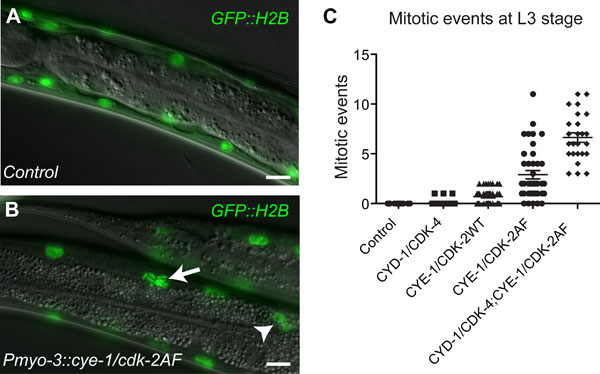The Proliferation vs. Differentiation Decision
Cell proliferation and differentiation are regulated in a highly coordinated and inverse manner during development and tissue homeostasis. Terminal differentiation usually coincides with cell cycle exit and is thought to engage stable transcriptional repression of cell cycle genes. We study the robustness of the post-mitotic state, using C. elegans muscle cells and neurons as our model.

G1 Cyclin/CDK expression induces mitotic events in body-wall muscle cells. (A) Control animal expressing a GFP::H2B fusion protein in body-wall muscle. (B) Animals that express Pmyo-3::CYE-1, Pmyo-3::CDK-2AF and Pmyo-3::GFP::H2B together show chromosome condensation (arrow) and nuclear division (arrowhead) in differentiated body-wall muscle. (C) Quantification of mitotic events for each Cyclin/CDK combination at the L3 stage. Each dot represents the number of mitotic muscle nuclei (with condensed DNA, metaphase or anaphase figures or nuclear division) in a single animal. In each animal, 58 muscle nuclei anterior of the prospective vulva were counted, to exclude muscle cells formed during post-embryonic development in the Mesoblast lineage. The highest mitotic index was 12% (7/58) in the strain with both Cyclin/CDKs. Error bars represent S.E.M.
In preliminary experiments, we found that expression of a single cell cycle kinase together with its regulatory partner (Cyclin) induces a large number of cell division genes in muscle cells. While Cyclin D and E kinases often show similar activities, only C. elegans Cyclin D with CDK4 triggers DNA replication in muscle, and this complex induces a much broader transcriptional response than Cyclin E/CDK2. Despite activation of a substantial cell cycle program, Cyclin/CDK expression did not induce complete muscle cell division and failed to induce some key cell cycle regulators. Our results highlight distinct activities of Cyclin D and Cyclin E kinases, and indicate that cell-cycle gene expression remains remarkably flexible in differentiated cells. We propose that the post-mitotic state of differentiated cells is maintained by tight control of a limited set of regulatory genes (Korzelius et al., Plos Genetics, in press).
Currently, we use forward and reverse genetic screens to identify the crucial blocks to cell cycle re-entry in differentiated muscle cells and neurons.
Back to Overview